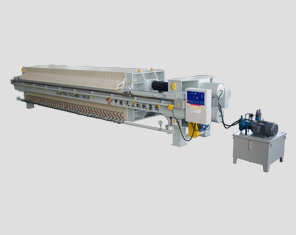Do you know how a filter press works?
The composition of the hydraulic pressing mechanism of the filter press is composed of a hydraulic station, an oil cylinder, a piston, a piston rod, and a Hafland card hydraulic station where the piston rod is connected with the pressing plate. Directional valve, pressure gauge, oil circuit, fuel tank.
When the hydraulic press is mechanically pressed, the hydraulic station supplies high-pressure oil, and the component cavity formed by the oil cylinder and the piston is filled with oil. When the pressure is greater than the frictional resistance of the pressing plate, the pressing plate slowly presses the filter plate. When the tightening force reaches the pressure value set by the overflow valve (displayed by the pointer of the pressure gauge), the filter plate, filter frame (plate and frame type) or filter plate (box type) is compressed, and the overflow valve begins to unload. , Cut off the power of the motor, the pressing action is completed, when it returns, the reversing valve changes direction, and the pressure oil enters the rod cavity of the oil cylinder. When the oil pressure can overcome the frictional resistance of the pressing plate, the pressing plate begins to retreat.
When the hydraulic pressing is automatic pressure maintaining, the pressing force is controlled by the electric contact pressure gauge. Set the upper and lower limit pointers of the pressure gauge to the value required by the process. When the pressing force reaches the upper limit of the pressure gauge, the power Cut off, the oil pump will stop the power supply, due to the possible internal leakage and external leakage of the oil circuit system, the pressing force will drop. When it drops to the lower limit pointer of the pressure gauge, the power supply is turned on, the oil pump starts to supply oil, and when the pressure reaches the upper limit, the power supply is cut off. The oil pump stops the oil supply, so as to ensure the effect of the pressing force in the process of reaching the filter material.
Filtration method: The way the filtrate flows out is clear flow filtration and undercurrent filtration. For open flow filtration, there is a water nozzle on the lower outlet hole of each filter plate, and the filtrate flows out from the water nozzle intuitively. Undercurrent filtration, the bottom of each filter plate is There is a liquid outlet channel hole, and the liquid outlet holes of several filter plates are connected to form a liquid outlet channel, which is discharged from the pipeline connected with the liquid outlet holes under the thrust plate.
Washing method: When the filter cake needs to be washed, sometimes it is one-way washing and two-way washing, and undercurrent one-way washing and two-way washing. Open current one-way washing means that the washing liquid enters in sequence from the washing liquid inlet hole of the thrust plate, and passes through the filter cloth. Then it passes through the filter cake and flows out from the non-porous filter plate. At this time, the liquid outlet nozzle of the perforated plate is in the closed state, and the liquid outlet water nozzle of the non-porous plate is in the open state. The top two side washing liquid inlet holes are washed twice, that is, the washing liquid is washed from one side and then washed from the other side. The washing liquid outlet and the inlet are in the diagonal direction, so it is also called two-way interspersed washing. Undercurrent one-way Flow washing is that the washing liquid enters the perforated plate in turn from the washing liquid inlet hole of the thrust plate, passes through the filter cloth and then passes through the filter cake, and flows out from the non-porous filter plate. Undercurrent two-way washing is that the washing liquid flows from the two sides above the stop plate The two washing liquid inlet holes are washed twice successively, that is, the washing is first washed from one side, and then washed from the other side. The exit of the washing liquid is in the diagonal direction, so it is also called undercurrent two-way interspersed washing.

Related News
- Filtration principle and operation of plate and frame filter press
- Different matters that should be paid attention to in the use of the filter plate of the diaphragm filter press
- What is the influence of the working period of the diaphragm filter press?
- The reason for the leakage of the box filter press
- Filter bag replacement and pressure condition of super essential oil filter
- The particularity of filter cloth used in plate and frame filter press
- What is the pressing principle of the diaphragm filter press?
- Introduction to filter maintenance
- What is the filtration speed, operation method and development direction of the filter?
- What is the impact of pump selection and insufficient pressure in filter presses?
- When should the Ultra Essential Oil Filter be replaced?
- What is the impact of the working cycle of the diaphragm filter press?
- How to judge the filterability of a filter press
- How to increase the working efficiency of the plate and frame filter plate of the filter press
- Advantages of Diaphragm Filter Press in Industrial Filtration
- Installation and commissioning of filter press
- Yellow rice wine press adopts diaphragm inflation pressing
- Why frontline workers say diaphragm filter presses are better
- Yellow rice wine press adopts diaphragm inflation pressing
- Filter Press Maintenance Tips


